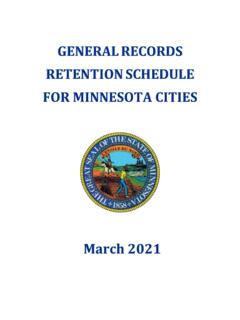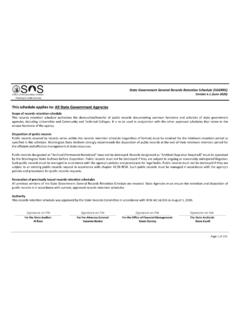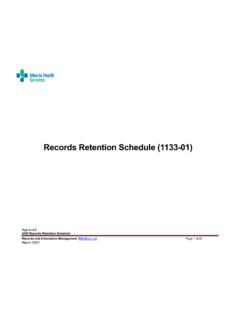Transcription of RECORDS CLASSIFICATION SYSTEM AND RETENTION …
1 RECORDS CLASSIFICATION SYSTEM AND RETENTION schedule Customized 2012 LGMA SYSTEM for the District of Sparwood Prepared by Michelle Barroca, , FY Information Management Consulting Wardner, BC August 27, 2014 TABLE OF CONTENTS INTRODUCTION .. 4 RECORDS CLASSIFICATION SYSTEM .. 4 BLOCK-NUMERIC RULES .. 5 SAMPLE CLASSIFICATION .. 6 RECORDS RETENTION schedule .. 7 SUMMARY OF 2012 LGMA RETENTION GROUPS .. 8 RESPONSIBILITIES .. 9 TIPS FOR CLASSIFYING RECORDS .. 9 DEFINITIONS .. 10 OVERVIEW OF THE RECORDS CLASSIFICATION 12 1.
2 ADMINISTRATION .. 13 2. BUILDINGS, FACILITIES AND PROPERTIES .. 24 3. EQUIPMENT AND SUPPLIES .. 29 4. INFORMATION SYSTEMS AND SERVICES .. 39 5. FINANCE .. 47 6. LEGAL MATTERS .. 60 7. PERSONNEL .. 66 8. LAND ADMINISTRATION .. 81 9. LEGISLATIVE AND REGULATORY SERVICES .. 87 10. COMMUNITY AND SOCIAL SERVICES .. 94 11. ENGINEERING AND PUBLIC WORKS .. 101 12. PARKS ADMINISTRATION .. 110 13. PLANNING AND DEVELOPMENT .. 115 14. PROTECTIVE SERVICES .. 123 15. RECREATION AND CULTURAL SERVICES .. 131 16. TRANSPORTATION AND TRANSIT SERVICES.
3 135 LOG OF CHANGES .. 140 (page left blank)4 INTRODUCTION This manual is based on the 2012 version of the Local Government Management Association s (LGMA) RECORDS Manual and has been customized for use at the District of Sparwood. The manual is both a RECORDS CLASSIFICATION SYSTEM and a RECORDS RETENTION and disposal schedule , which integrates these two key RECORDS management concepts into one comprehensive management plan for District RECORDS in all forms.
4 RECORDS and Information Management (RIM) is the field responsible for the efficient and systematic control of RECORDS (paper, electronic documents, microfiche, CD/DVDs, cassette tapes, etc.) throughout the record life cycle. RECORDS of permanent or archival value to the corporation are identified in the manual, and are to be transferred to an archives or off-site storage facility at the end of the life cycle (Final Disposition). RIM is a key driver in increasing staff productivity and organizational efficiency and provides significant benefits, such as: Improving the use of staff time Reducing storage costs Improving control of business and cultural information assets Improving compliance with legislation and standards Reducing our carbon imprint RECORDS CLASSIFICATION SYSTEM The RECORDS CLASSIFICATION SYSTEM is a block numeric plan for organizing RECORDS so they can be found when they are needed.
5 It represents a menu from which staff can select the appropriate classifications for RECORDS and files throughout the corporation. The RECORDS CLASSIFICATION SYSTEM helps to ensure that all members of an organization are filing RECORDS in the same way and are using common terminology. The end result is the cost-effective and efficient filing and information retrieval in the paper and electronic environments, and the systematic management of RECORDS throughout their life cycle. The structure of the RECORDS CLASSIFICATION SYSTEM is hierarchical and is based on the grouping of varied organizational functions.
6 The broader functions or subjects are placed at the top of the hierarchy, while more specific functions or subjects are placed at a lower level: 5 Sections: Highest level of the CLASSIFICATION hierarchy Used to bring a broad range of related functions or subjects together Primaries: Main functional or subject category within each Section Represented by a four digit number Includes a title and brief description of scope and content Contains at least one secondary Secondaries: Are sub-categories of a primary Consists of a two digit number and a title Are associated with RETENTION periods within the RECORDS RETENTION schedule -01 General is a standard secondary for every primary -20, -30, -40, etc.
7 , are usually reserved for secondaries that have case files Larger sub-categories can be broken down into tertiaries Block-Numeric Rules 1. Standard Primaries and Secondaries o The first primary in a section is always a General primary o Each primary has one standard General secondary 2. General to Specific o Rule of thumb: organize from the general to the specific o General primary and secondary at the beginning of each section and in each primary is used to classify RECORDS that cannot be classified to a more specific primary or secondary 3.
8 Alphabetization o Wherever possible, primaries and secondaries are sorted alphabetically o Often an alphabetic arrangement is recommended for physically arranging files by title within a given CLASSIFICATION o Used to facilitate filing and retrieval 4. Numbering o Gaps should be left between primary numbers as well as between secondary numbers o Enables new primaries and secondaries to be added in alphabetic order SectionPrimarySecondary6 Sample CLASSIFICATION The following is a sample CLASSIFICATION from the RECORDS manual.
9 Each element is identified and explained to better understand the RECORDS CLASSIFICATION SYSTEM and RETENTION schedule . Note: Numbers 1-5 correspond to the RECORDS CLASSIFICATION SYSTEM , and 6-8 to the RETENTION schedule . A SA FD 0360 COMMITTEES, BOARDS AND COMMISSIONS GENERAL RETENTION Group 6 SO nil P Includes RECORDS relating to the establishment, organization and functions of internal and external boards, commissions, committees, groups, panels, subcommittees, task forces and working groups not shown elsewhere.
10 Includes agenda, notices, minutes, reports and other RECORDS . For committees of council, see 0540. For Board of Variance, see 0365. For a further breakdown within an individual committee, the following tertiary (third level) categories may be used: -01 General -02 Agendas -03 Minutes -04 Appointments -05 Membership lists -06 Reports -07 Financial statements -08 Terms of reference -01 General -20 Internal Committees, etc., alpha by name -30 External Committees, etc., alpha by name OPR: All originating offices/departments 1.





